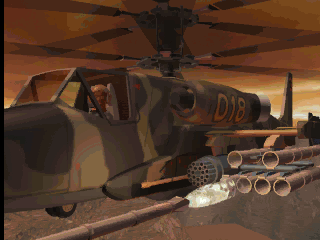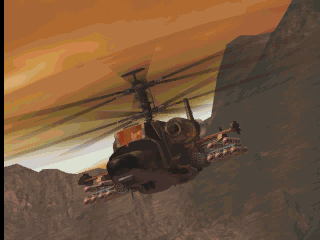Retro Replay Review
Gameplay
Werewolf vs. Comanche delivers a compelling blend of arcade-style action and helicopter simulation that will satisfy both casual players and flight sim enthusiasts. Divided into two distinct campaigns—Werewolf, piloting the Russian Ka-50 Hokum, and Comanche 2.0, flying the American RAH-66—each mode feels familiar yet refreshingly distinct. Missions range from high-speed armed reconnaissance and air superiority to ground-attack sorties, providing a varied mission set that keeps players engaged for hours on end.
(HEY YOU!! We hope you enjoy! We try not to run ads. So basically, this is a very expensive hobby running this site. Please consider joining us for updates, forums, and more. Network w/ us to make some cash or friends while retro gaming, and you can win some free retro games for posting. Okay, carry on 👍)
One of the standout features in this sequel is the ability to land your craft at forward operating bases to refill both fuel and ammunition. This simple addition introduces an element of resource management that encourages strategic planning, especially on longer missions. Rather than ending a sortie with an abrupt return to base, the option to touch down in hostile territory for a quick resupply heightens immersion and tension, as you must balance the risk of enemy fire with the need for more ordinance.
Multiplayer connectivity remains a strong selling point. By linking both Werewolf and Comanche 2.0 over a local network, you and a friend can engage in co-op missions or head-to-head dogfights. While the technology may feel dated by today’s standards, the thrill of hunting an enemy helicopter through voxel-rendered canyons or evading surface-to-air missiles never grows old. The network option breathes extra life into the package, extending replay value well beyond the single-player campaigns.
Controls are approachable yet offer enough depth to master more advanced maneuvers. Beginners can quickly get accustomed to the basic flight stick principles, while seasoned sim pilots will appreciate the subtle physics model that governs lift, drag, and missile lock-on behavior. The balance between accessibility and realism is one of the game’s greatest accomplishments, ensuring both new players and veterans find something to love.
Graphics
NovaLogic’s proprietary voxel engine, first introduced in 1993, continues to impress in Werewolf vs. Comanche. By eschewing traditional polygonal graphics in favor of voxels, the game achieves remarkably smooth terrain rendering and draw distances that few contemporaries could match. Mountains, valleys, and desert plains blend seamlessly, creating immersive environments that maintain a steady frame rate on modest hardware.
While textures may appear blocky when viewed up close, the overall visual presentation remains coherent and stylized. The distinctive look of voxel landscapes lends the game a unique charm, making each mission feel like a playable watercolor painting of rugged terrain. Dynamic weather effects, such as drifting sandstorms or sudden cloud cover, add further depth to the visuals and occasionally challenge visibility, forcing players to rely on instruments.
Helicopter models are reasonably detailed given the era, with animated rotor blades, exhaust trails, and missile launch effects that pop against the backdrop. Cockpit views are functional and uncluttered, providing essential flight data without overwhelming the screen. External camera angles showcase the sleek silhouette of the RAH-66 and the robust frame of the Ka-50, ensuring fans of military aviation will recognize and appreciate the design cues of these real-world attack helicopters.
On the technical side, performance remains solid even when dozens of enemies and projectiles populate the battlefield. The voxel engine’s efficiency means minimal slowdowns, though texture pop-in can occur at higher altitudes. For its time, this graphical package strikes an excellent balance between playability and visual fidelity, and it still holds nostalgic appeal for retro gaming enthusiasts.
Story
Werewolf vs. Comanche opts for a mission-based structure rather than an overarching cinematic narrative. Players are briefed on objectives through concise text and audio-over-radio cues, creating a straightforward “knock out these targets” experience. While the lack of a deep storyline may disappoint those seeking character-driven drama, the no-nonsense approach keeps the focus squarely on the action.
Each mission brief adds a dash of Cold War–style intrigue, with hints of shifting alliances and escalating conflicts in hostile territories. Whether you’re disrupting enemy supply lines or providing close air support for ground forces, the context grounds the action without bogging it down in political exposition. For many players, the thrill of launching guided missiles and weaving through anti-aircraft fire is compelling enough to carry each scenario.
The two campaigns subtly contrast East and West perspectives. Werewolf’s Hokum missions emphasize raw firepower and aggressive tactics, while Comanche 2.0 focuses on stealth and precision strikes. This duality offers a pseudo-narrative tension that encourages replay, as you experience similar objectives with differing philosophies and hardware capabilities. Though not a blockbuster storyline, the split campaigns deliver variety and replay value.
Budget re-releases later packaged each title standalone, but playing both together provides the richest sense of scale. Linking missions via network play or tackling campaign switch-overs offers a loose narrative thread that binds the world of rotorcraft warfare into a cohesive, if minimalist, framework.
Overall Experience
Werewolf vs. Comanche stands as a testament to NovaLogic’s skill at marrying technological innovation with accessible gameplay. The use of the voxel engine not only delivers a distinctive aesthetic but also ensures smooth performance even on early ’90s PCs. Combined with the novel ability to land for refueling and the option to pilot two different attack helicopters, the package offers impressive depth for its age.
The game’s pace is brisk, and missions are designed to push players to think on their feet. Whether evading lock-ons in the Hokum or lining up a Hellfire shot in the Comanche, there is a constant rush of adrenaline. Multiplayer connectivity may feel retro today, yet it remains remarkably engaging when revisited with friends on a LAN setup. The simple pleasure of aerial combat holds up well, even as modern flight sims pursue hyper-realism.
While the narrative is more of a backdrop than a driving force, the factional interplay between East and West campaigns adds just enough context to keep you invested mission after mission. Budget re-releases have made each title more accessible for newcomers, and the combined edition of Werewolf vs. Comanche remains the definitive way to enjoy both sides of the conflict.
For fans of helicopter sims, retro gaming, or anyone seeking high-octane aerial action, Werewolf vs. Comanche offers an engaging and nostalgic ride. Its blend of approachable controls, strategic resource management, and networked multiplayer ensures that even decades after its initial release, the game still delivers a satisfying combat helicopter experience.
 Retro Replay Retro Replay gaming reviews, news, emulation, geek stuff and more!
Retro Replay Retro Replay gaming reviews, news, emulation, geek stuff and more!









Reviews
There are no reviews yet.